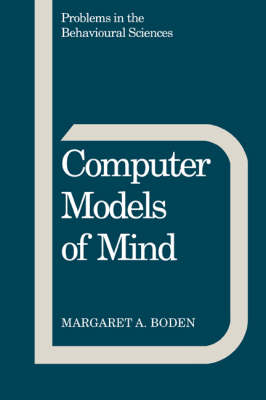
Computer Models of Mind
Computational approaches in theoretical psychology
Seiten
1988
Cambridge University Press (Verlag)
978-0-521-27033-5 (ISBN)
Cambridge University Press (Verlag)
978-0-521-27033-5 (ISBN)
What is the mind? How does it work? How does it influence behavior? Some psychologists hope to answer such questions in terms of concepts drawn from computer science and artificial intelligence, testing their theories by modeling mental processes in computers. This book shows how computer models are used to study many psychological phenomena - including vision, language, reasoning, and learning.
What is the mind? How does it work? How does it influence behavior? Some psychologists hope to answer such questions in terms of concepts drawn from computer science and artificial intelligence. They test their theories by modeling mental processes in computers. This book shows how computer models are used to study many psychological phenomena - including vision, language, reasoning, and learning. It also shows that computer modeling involves differing theoretical approaches. Computational psychologists disagree about some basic questions. For instance, should the mind be modeled by digital computers, or by parallel-processing systems more like brains? Do computer programs consist of meaningless patterns, or do they embody (and explain) genuine meaning?
What is the mind? How does it work? How does it influence behavior? Some psychologists hope to answer such questions in terms of concepts drawn from computer science and artificial intelligence. They test their theories by modeling mental processes in computers. This book shows how computer models are used to study many psychological phenomena - including vision, language, reasoning, and learning. It also shows that computer modeling involves differing theoretical approaches. Computational psychologists disagree about some basic questions. For instance, should the mind be modeled by digital computers, or by parallel-processing systems more like brains? Do computer programs consist of meaningless patterns, or do they embody (and explain) genuine meaning?
Preface; Acknowledgments; 1. Introduction; 2. Patterns, polyhedra, imagery; 3. Connectionist models of vision; 4. Parsing natural language; 5. Meaning and messages; 6. Reasoning and rationality; 7. Learning and development; 8. Is computational psychology possible? 9. Conclusion; References; Index of names; Index of subjects.
| Erscheint lt. Verlag | 29.4.1988 |
|---|---|
| Reihe/Serie | Problems in the Behavioural Sciences |
| Zusatzinfo | Worked examples or Exercises |
| Verlagsort | Cambridge |
| Sprache | englisch |
| Maße | 153 x 229 mm |
| Gewicht | 425 g |
| Themenwelt | Naturwissenschaften ► Biologie ► Humanbiologie |
| Naturwissenschaften ► Biologie ► Zoologie | |
| ISBN-10 | 0-521-27033-2 / 0521270332 |
| ISBN-13 | 978-0-521-27033-5 / 9780521270335 |
| Zustand | Neuware |
| Haben Sie eine Frage zum Produkt? |
Mehr entdecken
aus dem Bereich
aus dem Bereich
23 Techniken, um Stress abzubauen, Negativspiralen zu unterbrechen …
Buch | Softcover (2023)
FinanzBuch Verlag
18,00 €
produktiv sein ohne Stress – und mehr vom Leben haben
Buch | Softcover (2023)
dtv Verlagsgesellschaft
18,00 €
Wie Myrmecophile mit ihren Wirten interagieren
Buch | Softcover (2023)
Springer (Verlag)
69,99 €


